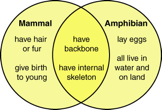| Writing Across the Curriculum
Writing is all around us. It is an integral part of society and a useful tool of communication. Students begin their writing education during language arts classes, but they are expected to apply these skills across the curriculum in all subject areas, such as science and social studies.
The Process
When writing across the curriculum, students may use the same writing process they would in language arts. To begin any writing project, students should make a plan to help them organize their ideas. When going to the grocery store, making a list ahead of time can help you stay organized and save time. Making a plan for a writing project applies the same concept. Some plans include creating pictures, lists, webs, Venn diagrams, and outlines. The plan will vary depending on the students' ages and writing topics.
After creating their plan, students will use it as a guide to write about their topic in complete sentences. Remind the student to always start with an introduction paragraph. No matter what the assignment, the introduction paragraph is critical. It is like the top layer of bread on a sandwich. Introduce the main ideas, saving the details for the following paragraphs to come. The detail paragraphs are the vegetables and meat of the sandwich. Finally, a concluding paragraph ends the piece. It is the bottom layer of bread holding the sandwich together. It wraps things up with final thoughts and comments.
After a draft is completed, students must go back and proofread their work. Many times, it will take multiple drafts to come up with a final piece. It is impossible to come up with a final copy in one draft. Remind your child that famous authors may write up to 100 drafts of their novels before they are considered "final" copies!
The Early Grades
Of course, younger children will not write three to five paragraph essays, but they will use the writing process. Kindergarten students practice writing their names and then "proofread," correcting for misshapen or misplaced letters. Adults even "publish" these early works by placing them on the wall or refrigerator. As children move into first and second grade, they begin to write stories and poems. Teachers also introduce the writing process: brainstorming, writing complete sentences, proofreading, and sharing their work. Even at this young age, you can talk to your children about the value of a main idea, supporting details, and a closing sentence. Working with them at an early age helps when they move into higher grades, writing in different subject areas.
Science
Let's apply this process to a science assignment. Say your child needs to compare and contrast the life of a mammal to that of an amphibian. They could begin by starting a Venn diagram as their plan. Make two ovals side by side on a piece of paper that overlap. Label one oval "Mammal" and the other "Amphibian." Record information unique to mammals in the "Mammal" oval, and record information unique to amphibians in the "Amphibian" oval. Characteristics they have in common are recorded in the section of overlap.  Once information is filed away, the student begins writing. They begin with their introduction paragraph. The next three paragraphs will be detail paragraphs, one on the mammal, one on the amphibian, and one on what they have in common. A concluding paragraph finishes their five-paragraph essay. Are they finished? Not until they have proofread!
Social Studies
How about a social studies assignment? Research reports are common projects and need to be started well in advance of their due dates. The student should pick an appropriate topic to match the assignment. Picking something they are interested in is always a plus! It's more fun writing about something they want to learn about. If the topic is U.S. Presidents, Thomas Jefferson might be a good candidate.
Once their teacher approves the topic, they should immediately start researching. Note cards are a great way to record their research, remembering to make a note card for each source they use. They should begin piling cards into stacks with similar information. For example, information on his childhood could be in one stack, information on his education could be in another, and information on his political background could be in a third. Then, the student can begin an outline to file away the information on their note cards.
Once enough information has been researched and a well-organized outline is completed, they may begin their rough draft by writing their information into complete sentences and paragraphs. Don't forget an introduction and a concluding paragraph. As always, proofread, proofread, proofread!
Writing across the curriculum is a challenging way for students to express what they have learned. Always remind them it is a process, and enjoying the process is half the fun!
|

